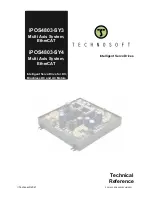
Epsilon EP-P Drive Reference Manual
31
Revision A4
www.controltechniques.com
must know the electrical angle (the angle between the motor magnetic field and stator coils).
Encoder Lines/Rev Exponent
Specifies a coefficient for determining the number of encoder lines per mechanical revolution. The supported values are 1 to
16383. The equation for determining the total number of encoder lines per revolutions is:
nLines = n*10x
where:
nLines = Total number of Encoder Lines
n = Motor Encoder Lines per Rev Coefficient
x = Motor Encoder Exponent
The total number of encoder lines is used both for commutation and for position/velocity control. To properly commutate the
motor, the drive must know the electrical angle (the angle between the motor magnetic field and stator coils).
Encoder Marker Angle
Specifies the electrical angle at which the marker (Z) pulse occurs with reference to V
TS
when the motor is spun in the encoder
reference direction. At power-up the drive obtains an initial estimate of the electrical angle from the status of the U, V and W
commutation tracks. This estimate can be off by as much as 30 °.
When the drive receives the marker pulse, the drive will, within one second, gradually shift the commutation to the more
accurate electrical angle specified by this parameter. The system will then operate more efficiently.
Encoder U-track Angle
Specifies the electrical angle at which the rising edge of the U commutation track will occur with reference to VTS when the
motor is spun in the encoder reference direction.
At power-up the drive looks at the status of the U, V and W commutation tracks and, using this parameter, obtains a crude (±
30 °) estimate of the electrical angle.
Encoder Reference Motion
Specifies the direction of motion assumed in phase plots of the encoder’s quadrature and summation signals. The supported
values are CW(1) and CCW(0). Your encoder may have the same phase plot but is generated from a different direction of
rotation. This parameter affects the way the drive interprets the quadrature and commutation signals.
Encoder Type
The supported values for this parameter are 1 and 0. If set to a 1 the drive uses the Encoder Marker angle as well as the
Encoder U Angle for commutation. If this parameter is set to a 0, the drive uses only the Encoder U Angle.
3.4.4
Run Auto-Tune Button
The drive has the ability to run an Auto-Tune operation thereby measuring several different motor parameters. Doing so allows
the drive to obtain certain parameters that are not typically provided by the motor manufacturer, and also optimizes other drive
parameters to work properly with the connected motor/load.
PowerTools Pro allows the user to initiate the Auto-Tune feature from the Motor view.
The following table shows which parameters must be entered in order to run the Auto-Tune feature, and which parameters are
measured by the Auto-Tune.
All Auto-Tune modes cause motion. It is important to read and understand the warnings and instructions on the Auto-Tune
windows. It is strongly recommended to unload the motor before performing an Auto-Tune.
Motor Parameters
Needed to Run Auto-Tune
Measured by Auto-Tune Mode #
Motor Name
Peak Current
Yes
Continuous Current Rating
Yes
Motor Poles
Yes
Rotor Inertia
3
Motor Ke
3
Phase Resistance
2,3
Phase Inductance
2,3
Max Operation Speed
Yes
Encoder Lines/Rev
Yes
1,2,3
Encoder Lines/Rev Exponent
Yes
1,2,3
Encoder Marker Angle
1,2,3
Encoder U-Marker
1,2,3
Encoder Reference Motion
1,2,3
Encoder Type
Summary of Contents for Epsilon EP-P
Page 2: ......
Page 124: ...110 Epsilon EP P Drive Reference Manual www controltechniques com Revision A4...
Page 200: ...186 Epsilon EP P Drive Reference Manual www controltechniques com Revision A4...
Page 218: ...204 Epsilon EP P Drive Reference Manual www controltechniques com Revision A4...
Page 238: ...224 Epsilon EP P Drive Reference Manual www controltechniques com Revision A4...
Page 244: ...230 Epsilon EP P Drive Reference Manual www controltechniques com Revision A4...
Page 247: ......
















































